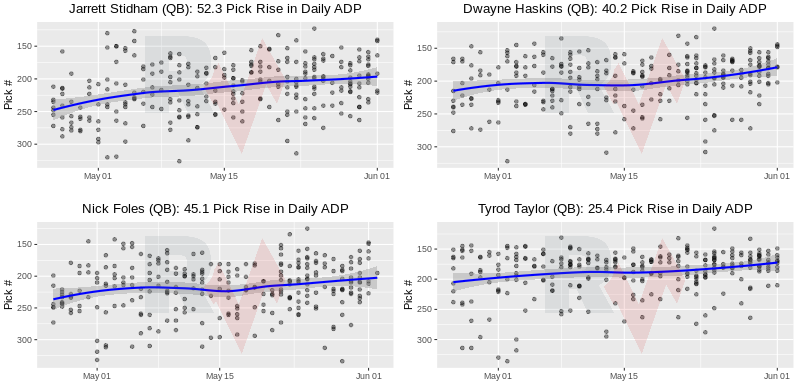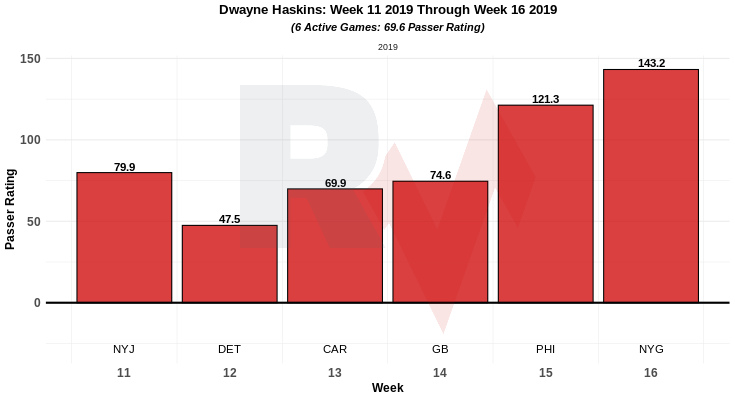Antonio Losada takes a look at the ADP variation of four quarterbacks from the start of May to the start of June and assesses their situations and the reasons behind those moves.
I am going to start this column by introducing the concept of ADP, which I'm pretty sure you are already familiar with. Just in case you're not, Average Draft Position (ADP) indicates the average position where a player is drafted over more than one fantasy football draft. You can consider it as the price you have to pay to draft and get a player on your team. A high ADP (that is, actually, a low-numbered ADP) means that a player is going off draft boards early, and thus you'll need to draft him in the first rounds if you truly want him.
Low or high ADP values, though, are not gospel. Each of us fantasy GMs have our strategies and value players differently depending on what we think is the most important for them to have in terms of abilities. No matter what, though, ADPs are good to know the "average value" of the "average GM" you'll be drafting against.
By now, with free agency and the draft well finalized and just a few players left to be signed, it makes sense to look at how ADPs are varying during the last month as we get closer to peak draft season.
Be sure to check all of our fantasy football rankings for 2025:- 2025 fantasy football rankings (redraft)
- Dynasty fantasy football rankings
- 2025 NFL rookie fantasy football rankings
- Best ball fantasy football rankings
- Quarterback fantasy football rankings
- Running back fantasy football rankings
- Wide receiver fantasy football rankings
- Tight end fantasy football rankings
Quarterbacks - ADP Risers
In this series, I’ll highlight players at each skill position seeing significant fluctuation since the start of May leading up to June using data from FFPC drafts that have taken place in that period. Today, it's time to look at four quarterback risers.
Jarrett Stidham, New England Patriots
The latest news surrounding New England and its quarterback position for 2020 has brought back the name of Cam Newton. It makes sense, considering Newton is still available as a free agent and New England is entering uncharted territory after Tom Brady's exit. But you better hold your horses. The Patriots aren't signing Newton, and look increasingly willing to give "second-year rookie" Stidham the reins of the team.
Stidham only attempted four passes in three games last year, functioning strictly as a backup, but he's a fourth-rounder drafted in 2019, and if he proves his worth he might become New England's QB1 of the future. He projects to score 196.4 PPR points in 2020 (QB31) and is part of a perennial contender, so the rise is understandable if only because of the franchise's past.
Nick Foles, Chicago Bears
Things start to get saucy when moving to Chicago and the ongoing Nick Foles vs. Mitchell Trubisky battle. Sure, we won't have spring nor probably summer camps where the actual battle would take place on a football field, but at least we have a war of words. The Bears have indicated that there will be an open competition for the starting role, and if we're honest, I think most of us would like to have super-sub Foles manning our team rather than walking-disappointment Trubisky.
Foles finished last season with a paltry 51.1 PPR points, but he also missed basically all year and could only play two true games, in which he averaged 20.2 PPG throwing for 272-plus yards in each. While Trubisky played 15 games, he only reached 272 yards in three of those matches and he threw five interceptions in those three games combined.
Trubisky's year was a carousel of performances, and his 17 PPG on the 14 games he completed fall short of what Foles has shown during his career. Even if Trubisky gets the starting job to start the year, all odds are against him to retain it for the whole season.
Dwayne Haskins Jr., Washington Redskins
People are slowly but surely buying into Haskins. And I love it, but I hate it too. I hate it because that means Haskins will be harder to get and more expensive in the drafts I'll take part in. I love it because I think Haskins' time is about to come and that he's more than capable of being a really good player for Washington.
Per PFF, Haskins projects to finish 2020 as the QB27, far from a QB1 level and even out of the second tier of players at the position, but I don't see why he couldn't slide into those groups down the road this year.
Haskins started 2019 slow, threw three interceptions to no TDs in his first game (Week 4), and wasn't on the field again until Week 8 while not starting his first game until Week 9. From that point on, though, and in seven games he threw seven touchdowns and only three interceptions.
Not bad for a rookie in his first bunch of starts. Haskins had three games over 14 PPR points and two with 19+ fantasy points. I'm not saying he's a 20-PPG player, but he's shown he's able to have back-to-back multi-TD performances in him and I'd bet on a developmental jump this year.
Tyrod Taylor, Los Angeles Chargers
Not hard to understand what's going on here, even easier if you've read the couple of paragraphs about Haskins I wrote above. The Chargers are this year where Washington was last year. They have a veteran (Taylor) and a recently drafted rookie (Justin Herbert) as their main quarterbacks, and they'll start the year by letting the freshman catch some tape and experience the bench before throwing him under the fire of starting games.
Taylor is getting the QB1 role in Los Angeles at least to start the season. And Taylor is far from a bad player, if at all. Taylor entered the league all the way back in 2011 and has started 46 games in his nine pro years.
His stint as No. 1 in Buffalo (2015-17) is the one we can look at to get the best feeling for his talents. Starting for the Bills he finished those three years as the QB14, QB9, and QB16, always reaching 222+ PPR points and averaging 19.4, 18.1, and 14.8 PPG respectively. Taylor is still going undrafted in most 12-team leagues but projects as a 234 fantasy points player, good for mid-QB2 level.






 RADIO
RADIO



























